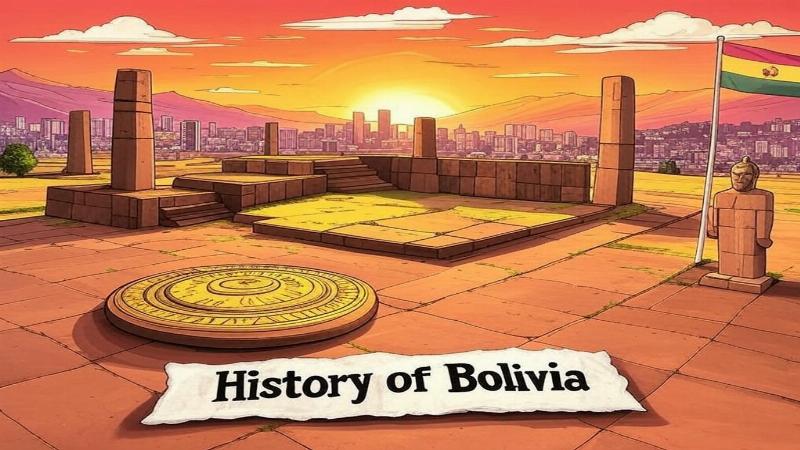Place for ads

Bolivia, a landlocked nation in the heart of South America, is a country where ancient legacies meet modern ambitions. Spanning 1,098,581 square kilometers, it sits between Peru, Brazil, Paraguay, Argentina, and Chile, its rugged Andes and sprawling lowlands shaping its story. Known today for its vibrant indigenous cultures and natural wealth, Bolivia’s past is a rich mosaic of pre-Columbian empires, colonial exploitation, and a turbulent path to sovereignty. In this article, we’ll journey through Bolivia’s history, from its earliest inhabitants to its contemporary challenges, uncovering the milestones that define this enduring nation.
Bolivia’s human history stretches back to around 12,000 BCE, when hunter-gatherers roamed its highlands and valleys. Archaeological sites like Viscachani reveal stone tools and bones, evidence of these Paleo-Indian nomads. By 2000 BCE, the Archaic period brought farming—pottery shards near Lake Titicaca show quinoa and potato cultivation, staples that still sustain Bolivians.
The Aymara and Quechua peoples’ ancestors emerged around 1000 BCE, settling the Altiplano. Rock art in Oruro and early villages like Chiripa hint at organized societies, trading salt and obsidian. These groups laid the groundwork for the sophisticated cultures that would later rise in Bolivia’s highlands.
Place for ads
By 600 CE, the Tiwanaku civilization flourished near Lake Titicaca, a marvel of pre-Columbian engineering. Its capital, Tiwanaku, boasted the Gateway of the Sun and Akapana pyramid, built with precision-cut stones. Tiwanaku’s people mastered irrigation, growing crops at 3,800 meters, and traded across the Andes—llama caravans carried goods to Peru and Chile.
Tiwanaku’s peak (600–1000 CE) saw a population of 20,000, its influence stretching to modern Argentina. Its decline—likely from drought—around 1000 CE left a vacuum, filled by Aymara kingdoms like Lupaqa and Colla. By the 15th century, the Inca Empire absorbed Bolivia, fortifying it with sites like Iskanwaya, blending local traditions with Cusco’s rule.
In 1532, Francisco Pizarro’s conquest of the Inca opened Bolivia to Spain. By 1538, conquistadors like Gonzalo Pizarro reached the Altiplano, founding La Paz in 1548 as a trade hub. The 1545 discovery of silver in Potosí’s Cerro Rico transformed Bolivia into Spain’s treasure chest—millions of tons fueled Europe’s economy.
Colonial rule was brutal—enslaved Aymara and Quechua mined under horrific conditions, dying by the thousands. Potosí’s mint churned out coins, but wealth flowed to Spain, leaving Bolivia a backwater. Rebellions—like Túpac Katari’s 1781 siege of La Paz—shook Spanish control, though they were crushed, sowing seeds of resistance.
The 1809 Chuquisaca Revolution sparked Bolivia’s independence struggle, inspired by Napoleon’s weakening of Spain. Simón Bolívar and Antonio José de Sucre led the fight—Sucre’s 1825 victory at Ayacucho freed Upper Peru. On August 6, 1825, Bolivia was born, named for Bolívar, with Sucre as its first president.
Early independence was chaotic—border wars with Chile and Peru, and internal coups plagued the young nation. The 1836–1839 Peru-Bolivian Confederation under Andrés de Santa Cruz collapsed under foreign pressure, shrinking Bolivia’s territory. By the 1879 War of the Pacific, Chile seized Bolivia’s coast, locking it inland.
The late 19th century brought a tin boom— magnates like Simón Patiño grew rich, but workers toiled in squalor. The 1903 Acre War lost land to Brazil, further shrinking Bolivia. Political instability reigned—over 60 presidents by 1900—while indigenous majorities stayed marginalized, their lands seized by elites.
The 1932–1935 Chaco War with Paraguay was a disaster—60,000 died, and Bolivia lost the oil-rich Chaco. Defeat fueled reform— the 1952 Revolution under Víctor Paz Estenssoro’s MNR party nationalized mines, gave land to peasants, and suffrage to all. Yet, economic woes and coups persisted, toppling Paz in 1964.
The 1960s and ’70s saw military rule—Hugo Banzer’s 1971–1978 regime crushed dissent but built roads and schools. Che Guevara’s 1967 guerrilla campaign ended in his death near Vallegrande, a failed spark for revolution. Coups rocked Bolivia until 1982, when democracy returned under Hernán Siles Zuazo.
The 1980s brought hyperinflation—prices soared 24,000%—until neoliberal reforms under Paz Estenssoro (1985–1989) stabilized the economy, slashing state jobs. Indigenous unrest grew—coca farmers clashed with U.S.-backed eradication, birthing Evo Morales’ MAS party, a voice for the marginalized.
In 2006, Evo Morales became Bolivia’s first indigenous president, nationalizing gas and rewriting the constitution to empower Aymara and Quechua. Poverty dropped, but his 2019 bid for a fourth term sparked fraud claims—protests and military pressure forced him to flee to Mexico.
Jeanine Áñez’s 2019–2020 interim rule polarized Bolivia—violence killed dozens. Luis Arce, Morales’ ally, won in 2020, facing economic scars from COVID-19 and drought. Today, Bolivia’s 12 million people navigate resource wealth—lithium, gas—against inequality and climate woes.
Bolivia’s history is a testament to endurance—from Tiwanaku’s grandeur to colonial chains, independence to modern upheaval. Its highlands echo with ancient voices, its cities pulse with change. As Bolivia strides forward, its past fuels a story of grit and hope.
Place for ads